
 One Giant Leap For Mankind
One Giant Leap For Mankind
人类的一大步
On July 20, 1969, humans walked on another world for the first time in history, achieving the goal that President John F. Kennedy had set in 1961, before Americans had even orbited the Earth.
1969 年7月 20日,人类有史以来第一次踏上了另一个世界,实现了约翰·肯尼迪总统在1961年设定的目标,当时美国人还没有绕地球轨道飞行。
Temperatures Across Our Solar System
整个太阳系的温度
What’s the weather like out there? We mean waaaay out there in our solar system – where the forecast might not be quite what you think.
外面的天气怎么样?我们的意思是在我们的太阳系中,那里的预测可能并不完全像你想象的那样。
Let’s look at the mean temperature of the Sun, and the planets in our solar system. The mean temperature is the average temperature over the surface of the rocky planets: Mercury, Venus, Earth, and Mars. Dwarf planet Pluto also has a solid surface. But since the gas giants don’t have a surface, the mean is the average temperature at what would be equivalent at sea level on Earth.
让我们看看太阳的平均温度,以及我们太阳系中的行星。平均温度是岩石行星表面的平均温度:水星、金星、地球和火星。矮行星冥王星也有固体表面。但是,由于气态巨行星没有表面,因此平均温度相当于地球上海平面的平均温度。

Sun 太阳
Let’s start with our Sun. You already know the Sun is hot. OK, it’s extremely hot! But temperatures on the Sun also are a bit puzzling.
让我们从我们的太阳开始。你已经知道太阳很热。好吧,天气非常热!但太阳上的温度也有点令人费解。
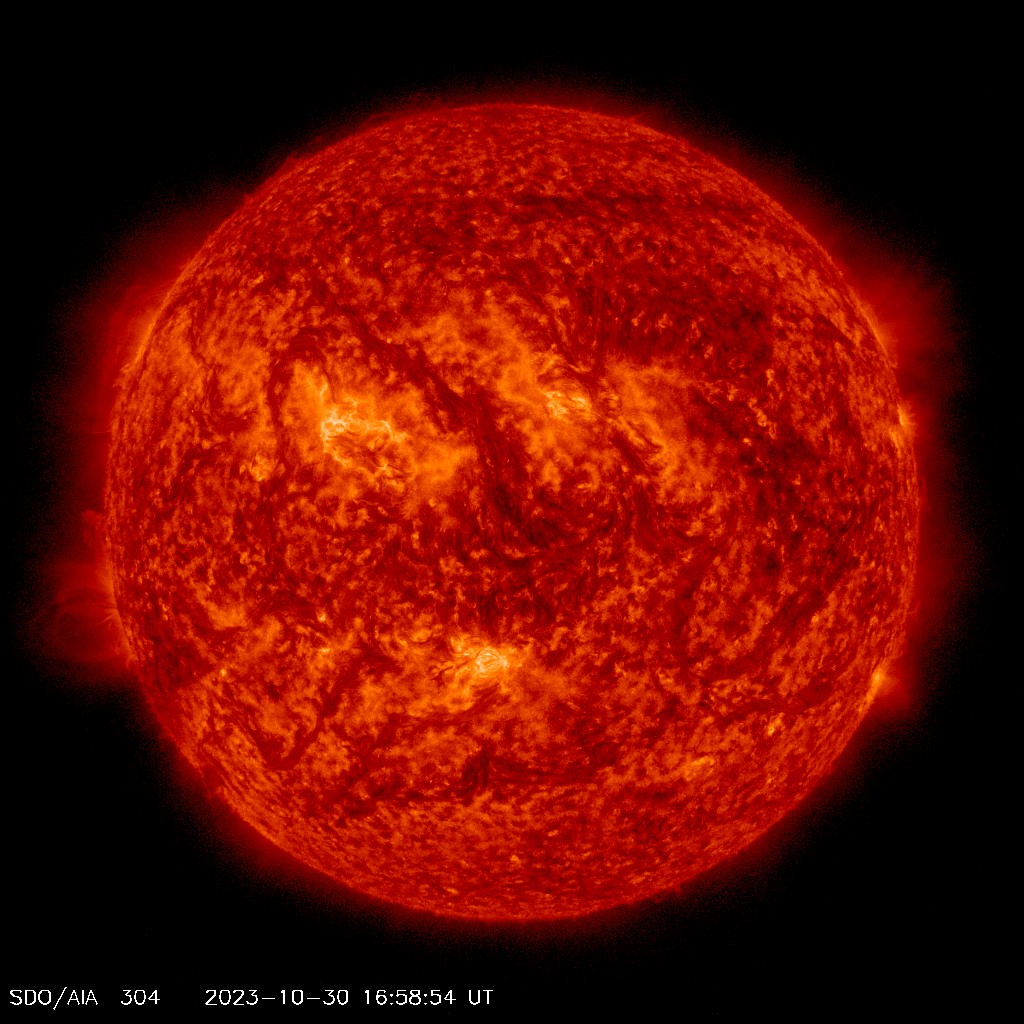
2023年10月30日,美国宇航局太阳动力学天文台拍摄的太阳图像。
The hottest part of the Sun is its core, where temperatures top 27 million°F (15 million°C). The part of the Sun we call its surface – the photosphere – is a relatively cool 10,000° F (5,500°C). In one of the Sun’s biggest mysteries, the Sun’s outer atmosphere, the corona, gets hotter the farther it stretches from the surface. The corona reaches up to 3.5 million°F (2 million°C) – much, much hotter than the photosphere.
太阳最热的部分是它的核心,温度高达2700万华氏度(1500万摄氏度)。我们称之为太阳表面的部分 - 光球层 - 是一个相对凉爽的10,000°F(5,500°C)。在太阳最大的谜团之一中,太阳的外层大气,日冕,离地表越远,温度就越高。日冕的温度高达350万华氏度(200万摄氏度),比光球层要热得多。
So some temperatures on the Sun are a bit upside down. How about the planets? Surely things are cooler on the planets that are farther from the Sun.
所以太阳上的一些温度有点颠倒。行星呢?当然,在离太阳较远的行星上,情况会更凉爽。
Well, mostly. But then there’s Venus.
嗯,主要是。但还有金星。
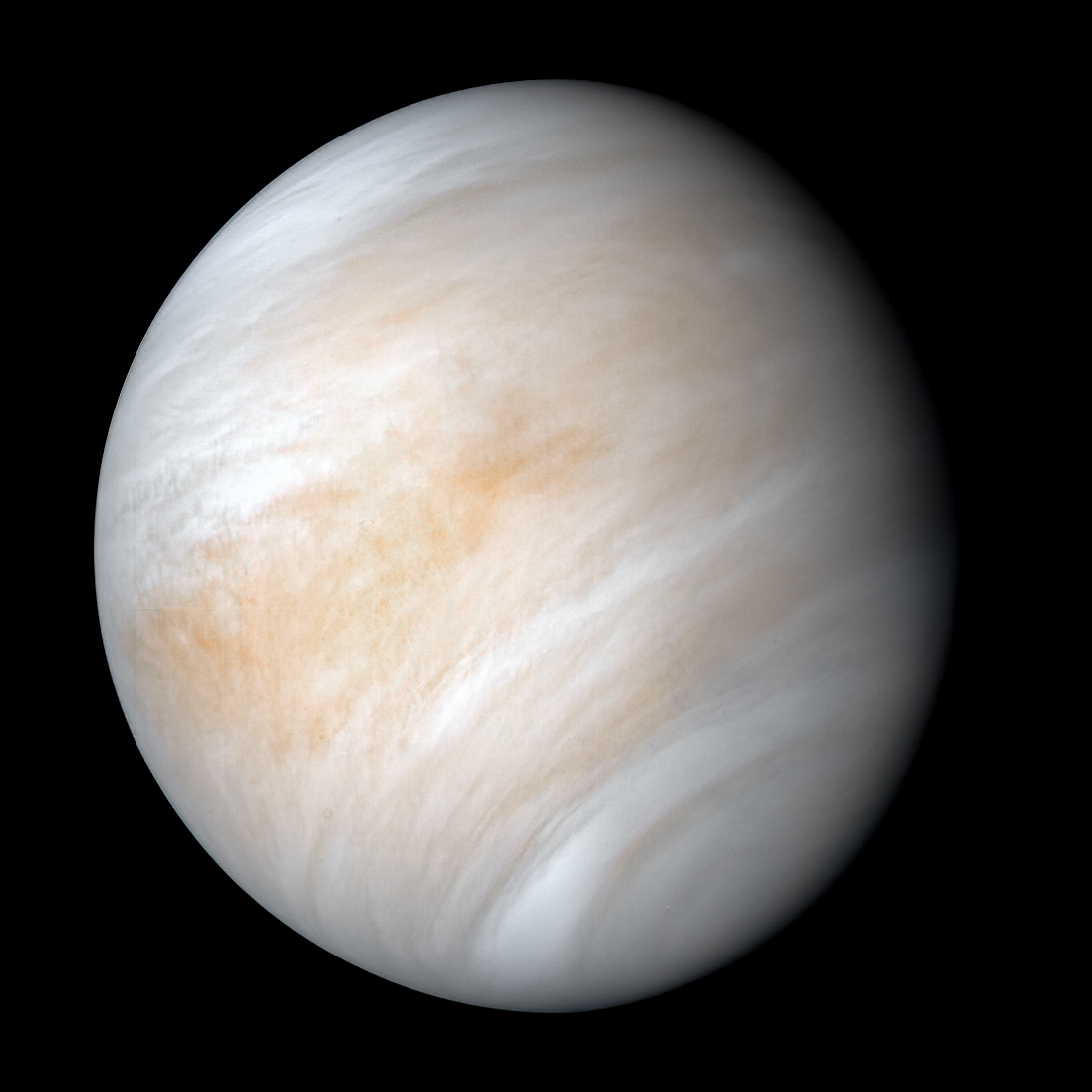
当它加速离开金星时,美国宇航局的水手10号宇宙飞船捕捉到了这颗看似平静的地球大小的行星,包裹在密集的全球云层中。但是,与其宁静的外表相反,金星的云球是一个充满高温、压垮大气压和腐蚀性酸云的世界。
Venus 金星
Venus is the second closest planet to the Sun after Mercury, with an average distance from the Sun of about 67 million miles (108 million kilometers). It takes sunlight about six minutes to travel to Venus.
金星是仅次于水星的第二近行星,与太阳的平均距离约为6700万英里(1.08亿公里)。阳光到达金星大约需要六分钟。
Venus also is Earth’s closest neighbor and is similar in size. It has even been called Earth’s twin. But Venus is shrouded in clouds and has a dense atmosphere that acts as a greenhouse and heats the surface to above the melting point of lead. It has a mean surface temperature of 867°F (464°C).
金星也是地球最近的邻居,大小相似。它甚至被称为地球的双胞胎。但是金星笼罩在云层中,并且具有浓密的大气层,可以充当温室并将表面加热到铅的熔点以上。它的平均表面温度为 867°F (464°C)。
So Venus – not Mercury – is the hottest planet in our solar system. Save that bit of info for any future trivia contests.
因此,金星——而不是水星——是我们太阳系中最热的行星。保存这些信息以备将来的任何琐事竞赛使用。
Maybe Venus is hotter, but Mercury is the closest planet to the Sun. Surely it gets hot, too?
也许金星更热,但水星是离太阳最近的行星。 它肯定也会变热吗?
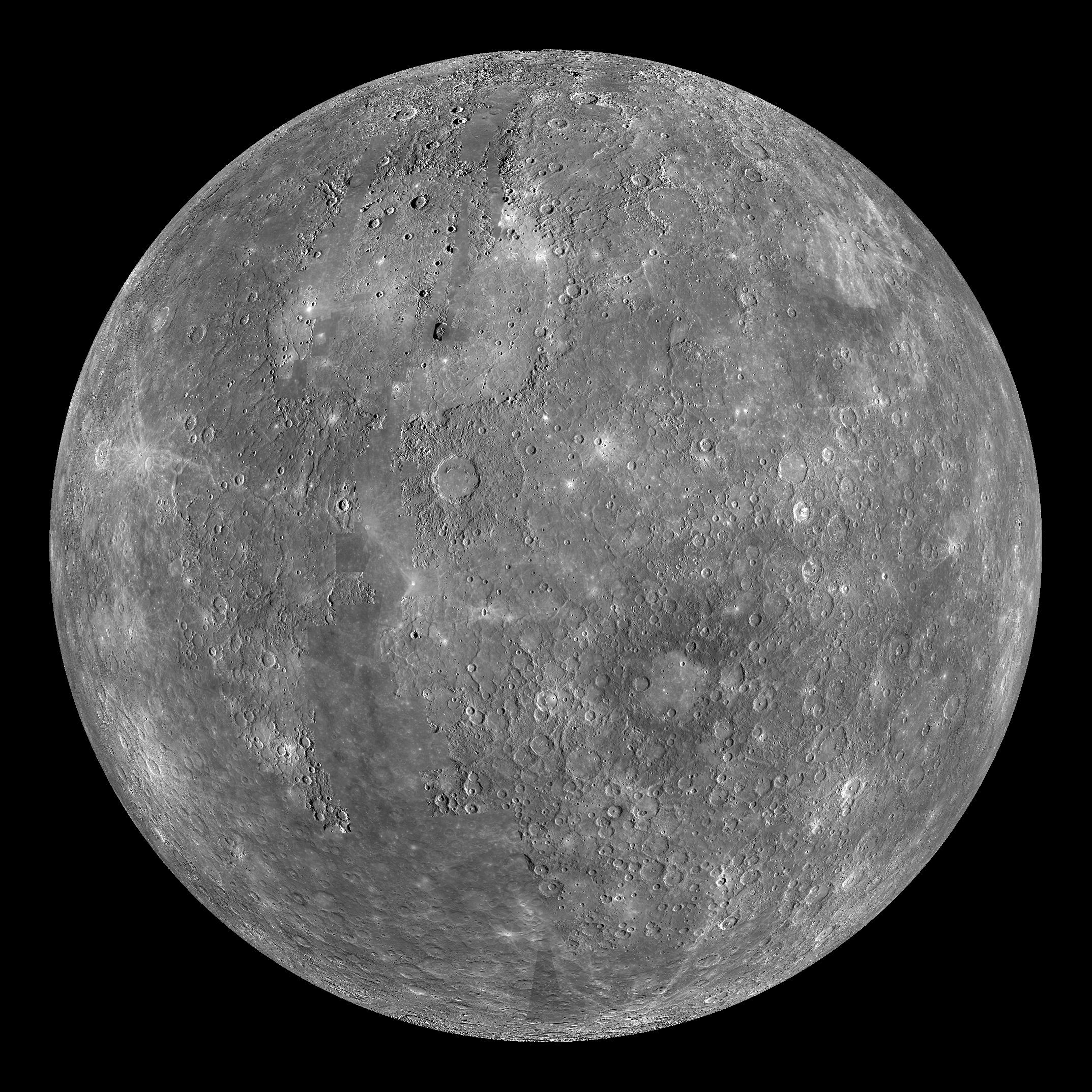
从美国宇航局的信使号(MESSENGER)看到的水星,这是第一艘绕水星运行的航天器。
美国宇航局/约翰霍普金斯大学应用物理实验室/华盛顿卡内基研究所
Mercury 水星
Mercury is about 36 million miles (57 million kilometers) from the Sun. From this distance, it takes sunlight about three minutes to travel to Mercury. Even though it’s sitting right next to the Sun – relatively speaking – Mercury gets extremely cold at night. It has a mean surface temperature of 333°F (167°C). Daytime temperatures get much hotter than the mean, and can reach highs of 800°F (430°C). But without an atmosphere thick enough to hold in the heat at night, temperatures can dip as low as -290°F (-180°C).
水星距离太阳约3600万英里(5700万公里)。从这个距离来看,阳光大约需要三分钟才能到达水星。尽管水星紧挨着太阳——相对而言——但水星在晚上会变得非常冷。它的平均表面温度为 333°F (167°C)。白天的温度比平均温度高得多,最高可达800华氏度(430°C)。但是,如果没有足够厚的大气层来承受夜间的热量,温度可能会低至-290°F(-180°C)。
Ahhh, Earth. We know about the weather here, right? Even Earth has some temperatures you may not have heard about.
啊,地球。我们知道这里的天气,对吧?甚至地球也有一些你可能没有听说过的温度。

来自深空气候观测站(DSCOVR)的地球图像。
Earth 地球
Earth is an average of 93 million miles (150 million kilometers) from the Sun. It takes about eight minutes for light from the Sun to reach our planet.
地球平均距离太阳9300万英里(1.5亿公里)。来自太阳的光到达我们的星球大约需要八分钟。
Our homeworld is a dynamic and stormy planet with everything from clear, sunny days, to brief rain showers, to tornados, to raging hurricanes, to blizzards, and dust storms. But in spite of its wide variety of storms – Earth generally has very hospitable temperatures compared to the other planets. The mean surface temperature on Earth is 59°F (15°C). But Earth days have some extreme temperatures. According to NOAA, Death Valley holds the record for the world’s highest surface air temperature ever recorded on Earth: 134°F (56.7°C) observed at Furnace Creek (Greenland Ranch), California, on July 10, 1913. Earth’s lowest recorded temperature was -128.6°F (-89.2°C) at Vostok Station, Antarctica, on July 21, 1983, according to the World Meteorological Organization.
我们的家园是一个充满活力和暴风雨的星球,从晴朗、阳光明媚的日子,到短暂的阵雨,到龙卷风,到肆虐的飓风,到暴风雪和沙尘暴。但是,尽管风暴种类繁多,但与其他行星相比,地球通常具有非常宜人的温度。地球上的平均表面温度为 59°F (15°C)。但是地球日有一些极端温度。根据美国国家海洋和大气管理局(NOAA)的数据,死亡谷保持着地球上有史以来最高的地表气温记录:1913年7月10日在加利福尼亚州炉溪(格陵兰牧场)观测到的134°F(56.7°C)。根据世界气象组织的数据,1983 年 7 月 21 日,南极洲沃斯托克站的地球最低记录温度为 -128.6°F (-89.2°C)。
NASA missions have found lots of evidence that Mars was much wetter and warmer, with a thicker atmosphere, billions of years ago. How about now?
美国宇航局的任务已经发现了大量证据表明,数十亿年前火星更潮湿、更温暖,大气层更厚。现在怎么样?

并排的动画图像显示了2018年全球沙尘暴如何笼罩这颗红色星球。这些图像是由美国宇航局的火星勘测轨道飞行器(MRO)拍摄的。
Mars 火星
Mars is an average distance of 142 million miles (228 million kilometers) from the Sun. From this distance, it takes about 13 minutes for light to travel from the Sun to Mars.
火星与太阳的平均距离为1.42亿英里(2.28亿公里)。从这个距离来看,光从太阳传播到火星大约需要13分钟。
The median surface temperature on Mars is -85°F (-65°C). Because the atmosphere is so thin, heat from the Sun easily escapes Mars. Temperatures on the Red Planet range from the 70s°F (20s°C) to -225°F (-153°C). Occasionally, winds on Mars are strong enough to create dust storms that cover much of the planet. After such storms, it can be months before all of the dust settles.
火星表面的平均温度为-85°F(-65°C)。由于大气层非常稀薄,来自太阳的热量很容易从火星逸出。这颗红色星球的温度范围从70s°F(20s°C)到-225°F(-153°C)。有时,火星上的风足够强大,可以产生覆盖地球大部分地区的沙尘暴。在这样的风暴之后,可能需要几个月的时间才能尘埃落定。
Two NASA rovers on Mars have weather stations. You can check the daily temps at their locations:
美国宇航局在火星上的两辆火星车都有气象站。您可以查看其位置的每日温度:
The ground temperature around the Perseverance rover ranges from about -136°F to 62°F (-93°C to 17°C). The air temperature near the surface ranges from about -118°F to 8°F (-83°C to -13°C).
毅力号火星车周围的地面温度范围约为-136°F至62°F(-93°C至17°C)。地表附近的气温范围约为-118°F至8°F(-83°C至-13°C)。
As planets move farther away from the Sun, it really cools down fast! Since gas giants Jupiter and Saturn don’t have a solid surface, temperatures are taken from a level in the atmosphere equal in pressure to sea level on Earth. The same goes for the ice giants Uranus and Neptune.
随着行星离太阳越来越远,它真的会迅速冷却下来!由于气态巨行星木星和土星没有固体表面,因此温度是从大气中压力与地球上海平面相等的水平获取的。冰巨星天王星和海王星也是如此。

美国宇航局的朱诺号宇宙飞船在飞越木星时拍摄了这张照片。这张照片突出了木星最著名的天气现象,即被称为大红斑的持续风暴。公民科学家凯文·M·吉尔(Kevin M. Gill)使用来自航天器JunoCam成像仪的数据创建了这张图像。
Kevin M. Gill (CC-BY) 根据 NASA/JPL-Caltech/SwRI/MSSS 提供的图像提供的图像提供增强图像
Jupiter 木星
Jupiter's stripes and swirls are beautiful, but they are actually cold, windy clouds of ammonia and water, floating in an atmosphere of hydrogen and helium. The planet’s iconic Great Red Spot is a giant storm bigger than Earth that has raged for hundreds of years. The mean temperature on Jupiter is -166°F (-110°C).
木星的条纹和漩涡很漂亮,但它们实际上是寒冷的、有风的氨和水云,漂浮在氢和氦的大气中。这个星球标志性的大红斑是一场比地球还大的巨大风暴,已经肆虐了数百年。木星上的平均温度为-166°F(-110°C)。
Jupiter is an average distance of 484 million miles (778 million kilometers) from the Sun. From this distance, it takes sunlight 43 minutes to travel from the Sun to Jupiter. Jupiter has the shortest day in the solar system. One day on Jupiter takes only about 10 hours (the time it takes for Jupiter to rotate or spin around once), and Jupiter makes a complete orbit around the Sun (a year in Jovian time) in about 12 Earth years (4,333 Earth days).
木星与太阳的平均距离为4.84亿英里(7.78亿公里)。从这个距离来看,太阳从太阳到木星需要43分钟。木星是太阳系中白天最短的。在木星上一天只需要大约10个小时(木星旋转或旋转一次所需的时间),木星在大约12个地球年(4,333个地球日)内绕太阳运行一个完整的轨道(木星时间为一年)。
Jupiter’s equator is tilted with respect to its orbital path around the Sun by just 3 degrees. This means the giant planet spins nearly upright and does not have seasons as extreme as other planets do.
木星的赤道相对于其围绕太阳的轨道路径仅倾斜3度。这意味着这颗巨行星几乎是直立旋转的,并且不像其他行星那样有极端的季节。
As we keep moving out into the solar system, we come to Saturn – the sixth planet from the Sun and the second largest planet in our solar system. Saturn orbits the Sun from an average distance of 886 million miles (1.4 billion kilometers). It takes sunlight 80 minutes to travel from the Sun to Saturn.
随着我们继续进入太阳系,我们来到了土星——太阳的第六颗行星,也是太阳系中的第二大行星。土星绕太阳公转的平均距离为8.86亿英里(14亿公里)。从太阳到土星需要 80 分钟的阳光。
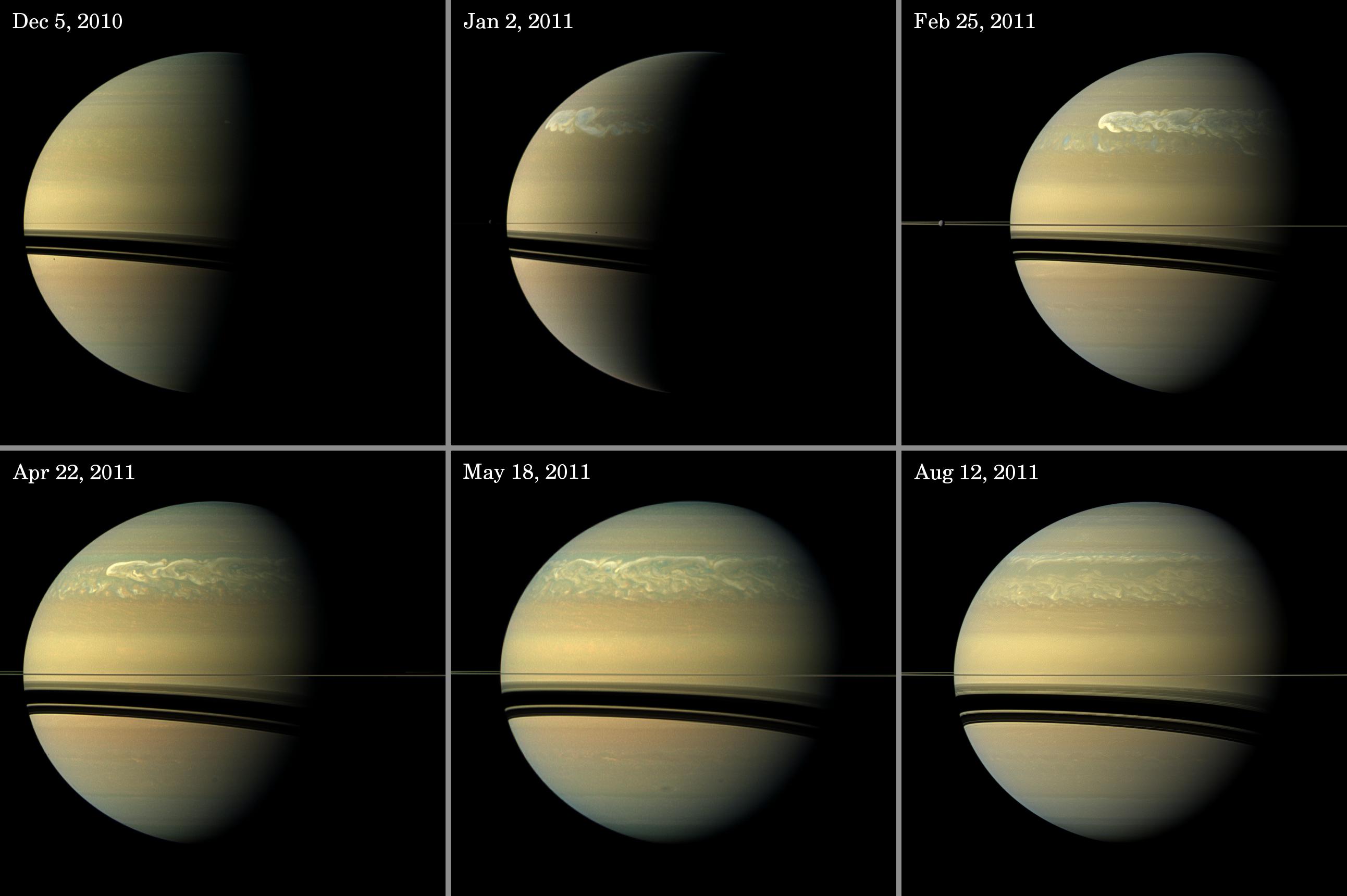
美国宇航局卡西尼号宇宙飞船的这一系列图像显示了自1990年以来土星上最大的风暴的发展。这些真彩色和合成的近乎真彩色的视图记录了这场风暴从2010年底开始到2011年年中的过程,展示了风暴的独特头部如何迅速变大,但最终被风暴的尾巴吞没。
NASA/JPL-加州理工学院/空间科学研究所
Saturn 土星
Like fellow gas giant Jupiter, Saturn is a massive ball made mostly of hydrogen and helium and it doesn’t have a true surface. The mean temperature is -220°F (-140°C).
与气态巨行星木星一样,土星是一个主要由氢和氦组成的巨大球体,它没有真正的表面。平均温度为 -220°F (-140°C)。
In addition to the bone-chilling cold, the winds in the upper atmosphere of Saturn reach 1,600 feet per second (500 meters per second) in the equatorial region. In contrast, the strongest hurricane-force winds on Earth top out at about 360 feet per second (110 meters per second). And the pressure – the same kind you feel when you dive deep underwater – is so powerful it squeezes gas into a liquid.
除了令人毛骨悚然的寒冷之外,土星高层大气中的风速在赤道地区达到每秒1,600英尺(每秒500米)。相比之下,地球上最强的飓风风速约为每秒360英尺(每秒110米)。而且压力——与你潜入水下深处时所感受到的压力相同——是如此强大,以至于将气体挤压成液体。

这部彩色电影由美国宇航局卡西尼号宇宙飞船于 2012 年 12 月 10 日拍摄的图像制作而成。这是土星北极独特的六边形急流的最高分辨率视图,被称为“六边形”。
NASA/JPL-加州理工学院/SSI/汉普顿大学
Saturn's north pole has an interesting atmospheric feature – a six-sided jet stream. This hexagon-shaped pattern was first noticed in images from the Voyager I spacecraft, and was more closely observed by the Cassini spacecraft in 2012. Spanning about 20,000 miles (30,000 kilometers) across, the hexagon is a wavy jet stream of 200-mile-per-hour winds (about 322 kilometers per hour) with a massive, rotating storm at the center. There is no weather feature like it anywhere else in the solar system.
土星的北极有一个有趣的大气特征——六面急流。这种六边形图案首先在旅行者一号航天器的图像中被注意到,并在2012年被卡西尼号航天器更仔细地观察到。六边形横跨约20,000英里(30,000公里),是每小时200英里(约每小时322公里)的波浪形急流,中心有一个巨大的旋转风暴。在太阳系的其他任何地方都没有像这样的天气特征。
Crane your neck to the side while we go check out the weather on Uranus, the sideways planet.
把你的脖子伸到一边,我们去看看天王星的天气,天王星是侧向行星。
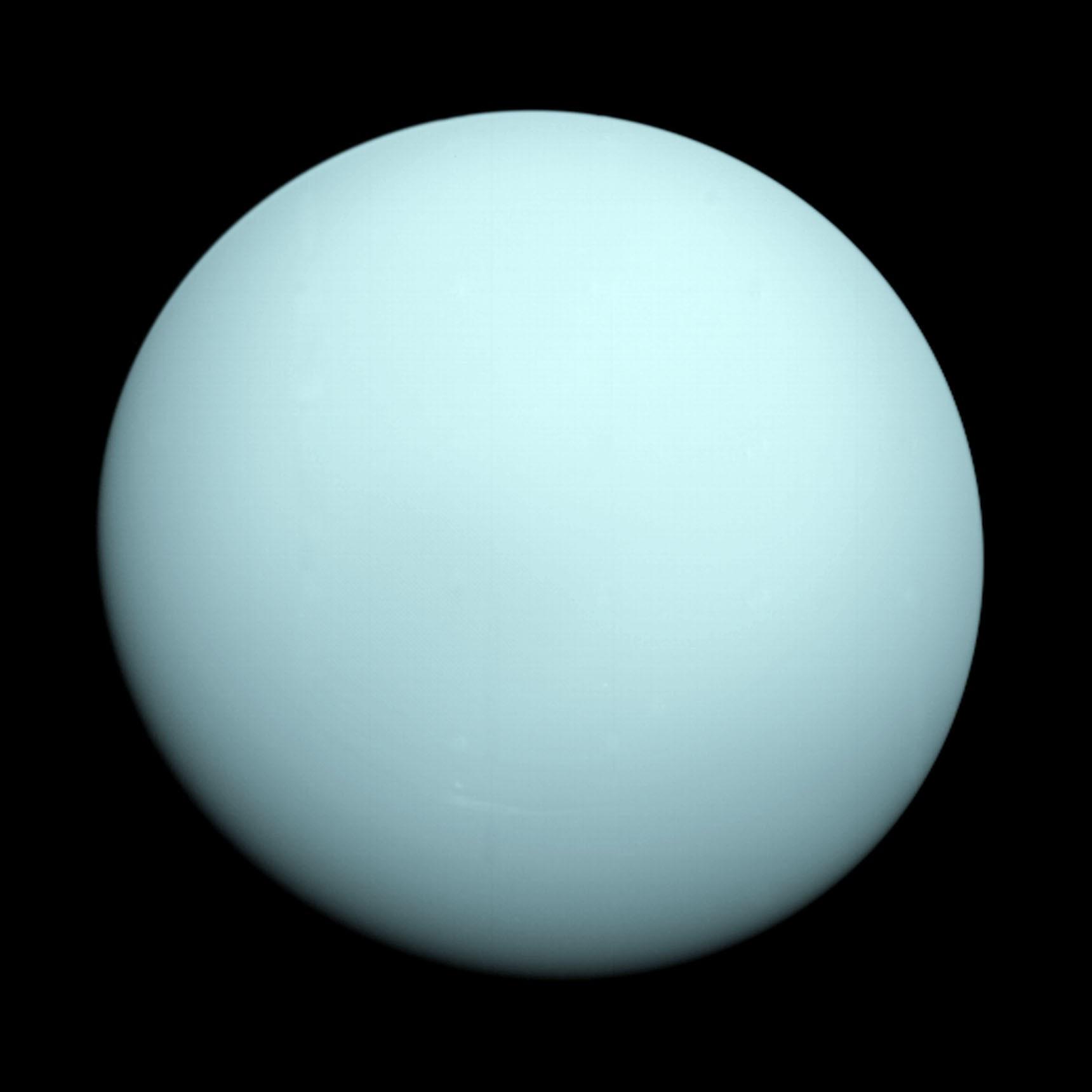
这是1986年旅行者2号飞船拍摄的天王星图像。
Uranus 天王星
The seventh planet from the Sun with the third largest diameter in our solar system, Uranus is very cold and windy. It has a mean temperature of -320°F (-195°C). Uranus rotates at a nearly 90-degree angle from the plane of its orbit. This unique tilt makes Uranus appear to spin sideways, orbiting the Sun like a rolling ball. And like Saturn, Uranus has rings. The ice giant is surrounded by 13 faint rings and 27 small moons.
天王星是太阳系中第七颗直径第三大的行星,非常寒冷多风。它的平均温度为 -320°F (-195°C)。天王星与其轨道平面成近90度角旋转。这种独特的倾斜使天王星看起来像是侧向旋转,像一个滚动的球一样绕着太阳运行。和土星一样,天王星也有光环。这颗冰巨星被13个微弱的光环和27颗小卫星包围。
Now we move on to the last major planet in our solar system – Neptune. What’s the weather like there? Well you would definitely need a windbreaker if you went for a visit. Dark, cold, and whipped by supersonic winds, giant Neptune is the eighth and most distant major planet orbiting our Sun. The mean temperature on Neptune is -330°F (-200°C).
现在我们进入太阳系中的最后一颗主要行星——海王星。那里的天气怎么样?好吧,如果你去参观,你肯定需要一件风衣。巨大的海王星黑暗、寒冷,被超音速风吹拂,是围绕太阳运行的第八颗也是最遥远的主要行星。海王星上的平均温度为-330°F(-200°C)。
And not to be outdone by Jupiter and its Great Red Spot, Neptune has the Great Dark Spot – and Scooter. Yep, Scooter.
木星及其大红斑也不甘示弱,海王星拥有大黑斑和滑板车。是的,滑板车。
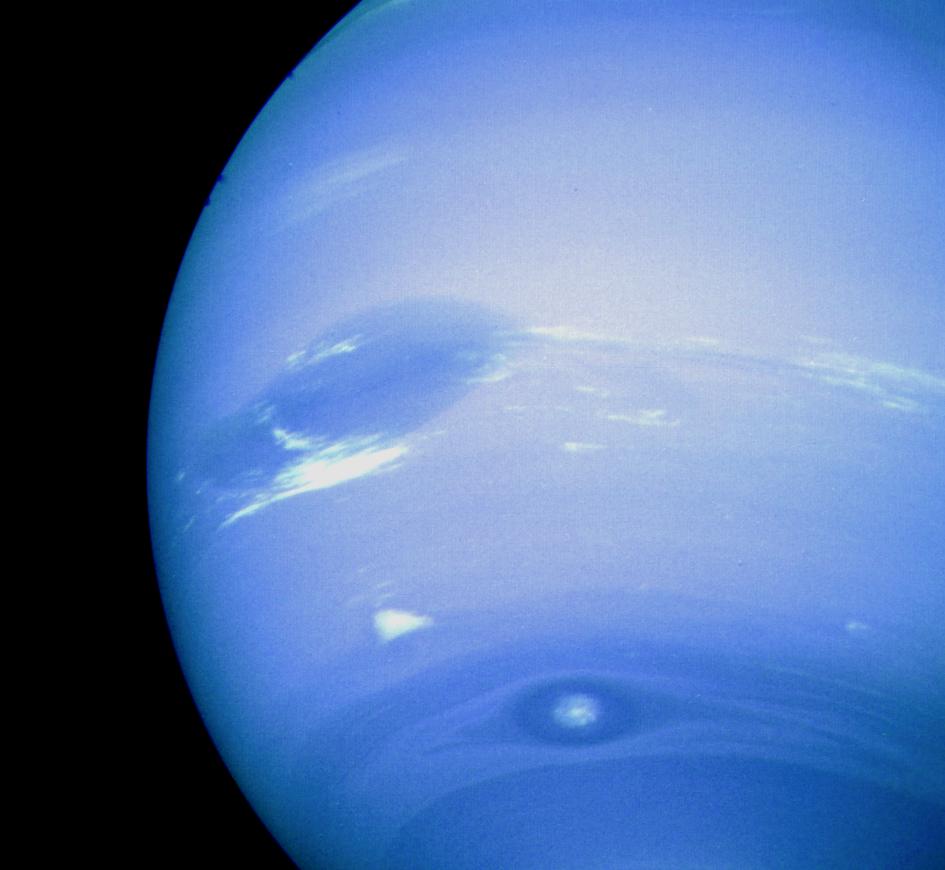
旅行者2号于1989年在海王星上拍摄了这些特征。
Neptune 海王星
This photograph of Neptune was created from two images taken by NASA’s Voyager 2 spacecraft in August 1989. It was the first and last time a spacecraft came close to Neptune. The image shows three of the features that Voyager 2 monitored. At the north (top) is the Great Dark Spot, accompanied by bright, white clouds that undergo rapid changes in appearance. To the south of the Great Dark Spot is the bright, triangular-shaped feature that Voyager scientists nicknamed "Scooter." Still farther south is the feature called "Dark Spot 2," which has a bright core.
这张海王星照片是根据美国宇航局的旅行者 2 号宇宙飞船于 1989 年 8 月拍摄的两张照片制作的。这是宇宙飞船第一次也是最后一次接近海王星。该图像显示了旅行者2号监测的三个特征。在北部(顶部)是大黑斑,伴随着明亮的白云,外观发生快速变化。在大黑斑的南面是明亮的三角形特征,旅行者号科学家将其昵称为“滑板车”。再往南是被称为“黑斑2”的特征,它有一个明亮的核心。
More than 30 times as far from the Sun as Earth, Neptune is not visible to the naked eye. In 2011, Neptune completed its first 165-year orbit of the Sun since its discovery.
海王星离太阳的距离是地球的30倍以上,肉眼看不到。2011年,海王星完成了自发现以来首次绕太阳运行165年。
That wraps up forecasting for the major planets.
对主要行星的预测到此结束。
But there is one more place we need to check out. Beyond Neptune is a small world, with a big heart – dwarf planet Pluto.
但是我们还需要检查一个地方。海王星之外是一个小世界,有着一颗大心脏——矮行星冥王星。
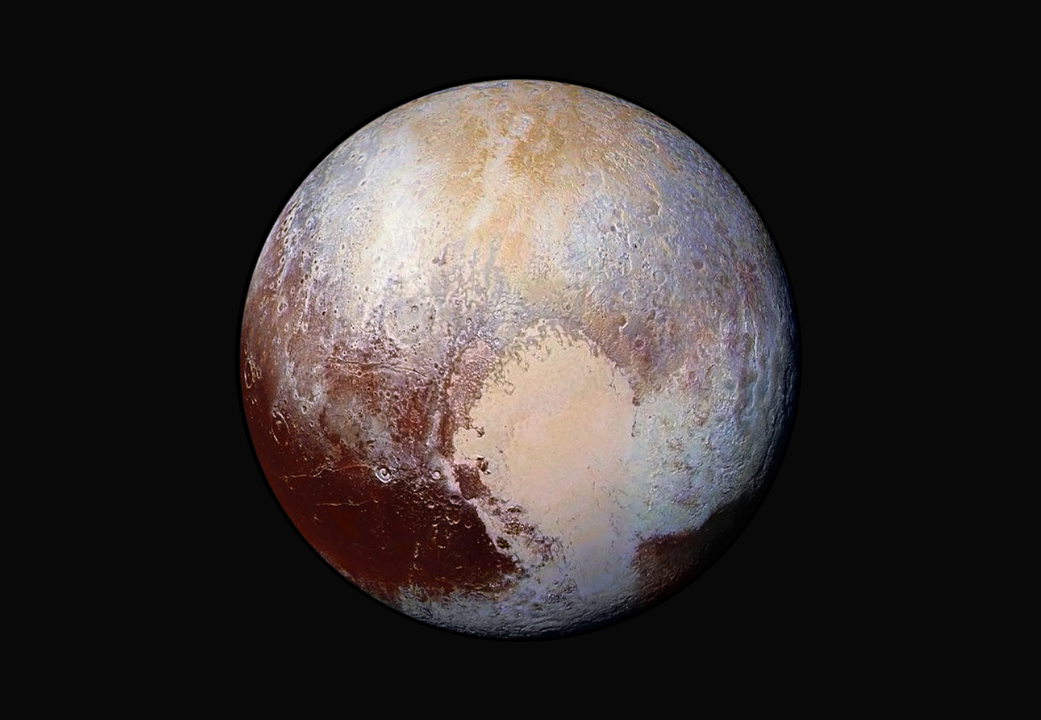
新视野号的科学家使用增强的彩色图像来检测冥王星表面成分和纹理的差异。
Pluto 冥王星
With a mean surface temperature of -375°F (-225°C), Pluto is considered too cold to sustain life. Pluto's interior is warmer, however, and some think there may be an ocean deep inside.
冥王星的平均表面温度为-375°F(-225°C),被认为太冷而无法维持生命。然而,冥王星的内部更温暖,有些人认为冥王星内部深处可能有一片海洋。
From an average distance of 3.7 billion miles (5.9 billion kilometers) away from the Sun, it takes sunlight 5.5 hours to travel to Pluto. If you were to stand on the surface of Pluto at noon, the Sun would be 1/900 the brightness it is here on Earth. There is a moment each day near sunset here on Earth when the light is the same brightness as midday on Pluto.
从距离太阳37亿英里(59亿公里)的平均距离来看,阳光需要5.5小时才能到达冥王星。如果你在中午站在冥王星表面,太阳的亮度将是地球上的1/900。在地球上,每天日落时分,光线的亮度与冥王星上的正午相同。
So the next time you’re complaining about the weather in your spot here on Earth, think about Pluto and all the worlds in between.
因此,下次当你抱怨你在地球上的天气时,想想冥王星和介于两者之间的所有世界。


























 被折叠的 条评论
为什么被折叠?
被折叠的 条评论
为什么被折叠?










